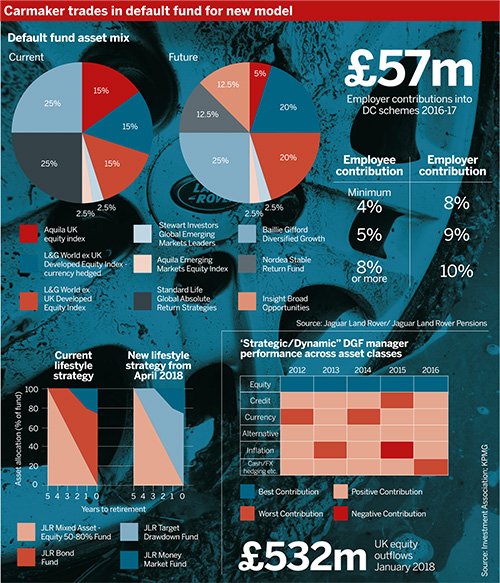UK automotive stalwart Jaguar Land Rover has embarked on a complete overhaul of its defined contribution offering in a bid to drive down costs and improve member outcomes.
Savings negotiated by the group with provider Zurich come as JLR transitions its members onto new administration and investment platforms, which aim to increase flexibility and improve members’ user experience.
Once transferred across, contributions will be invested in an updated set of default funds, both in the growth phase and in the run-up to retirement.
As part of a review exercise you often find that the trustees or the governance committee take the opportunity to review whether they’re getting value for money
Ken Anderson, Xafinity Punter Southall
For too long an afterthought to questions of defined benefit governance, anecdotal evidence now suggests DC trustees and employers are taking a more rigorous and demanding approach to negotiating with providers.
Member offering is set to improve
This approach is evident in JLR’s overhaul. The group announced to members in a winter newsletter that it would be transitioning to new platforms offered by provider Zurich.
The benefits, JLR said, would include an “easy-to-use member portal with improved modelling and attitude-to-risk tools”, the option to invest across more than one lifestyle or self-select fund at the same time, and flexi-access drawdown.
These advantages are not particular to customers replatforming with Zurich, said Richard Birkin, head of the DC solutions pensions team at professional services company KPMG.

“Zurich and others will have focused their time, attention and spend on the newer platform,” he said. The new infrastructure will typically offer “more functionality for the members” in areas such as segmented communications and engagement, better technology and more investment options, he said.
It is not a foregone conclusion that all schemes move to new platforms as soon as they are made available. A spokesperson for Zurich said that all the changes made to JLR’s offering were driven by client demand rather than any automated shift.
Newer is not always better. “In some cases the provider is running multiple platforms and they don’t feel hugely different,” Birkin explained.
But he said he was heartened to see employers and trustees demanding more from providers where differences do exist.
Costs are coming down
JLR’s renegotiation has yielded tangible benefits in terms of the fees incurred by members.
“As a result of these changes, and further negotiations with Zurich, we have achieved further reductions in costs for members investing in the default fund and indeed many of the other funds available, whilst maintaining a similar balance of risk and expected returns,” the company’s HR department told employees in its newsletter.
Key points
JLR will change investment and administration platforms from April
Costs expected to come down and member functionality will improve
Default growth fund to trim UK equities in favour of global stocks
Group keeps faith in diversified funds, but ditches Gars
New lifestyling strategy will target drawdown
Ken Anderson, head of DC solutions at consultancy Xafinity Punter Southall, said reviewing investment arrangements at the same time as other key changes was good practice.
“As part of a review exercise you often find that the trustees or the governance committee take the opportunity to review [whether] they’re getting value for money,” he said. “Part of that is to look at the charges that members pay.”
UK trimming has diversification benefits
Of course, cost is only one half of the value for money calculation. From 2018, JLR will update the asset mix in its default fund, the JLR Mixed Asset – Equity 50-80% Fund, “with the aim of reducing risk without reducing longer-term returns”.
Notably, that reallocation involves a slashing of the fund’s exposure to UK passive equities managed by BlackRock from 15 to 5 per cent.
The redemptions will be used to boost existing allocations to two L&G World ex UK Developed Equity Index funds, both currency hedged and unhedged, from 15 to 20 per cent each.
The move comes as the Investment Association recorded significant net outflows of £532m from funds investing in UK equities during January this year. Over a 12-month average, the net outflow was £219m.
But JLR’s shunning of UK stocks might not be the Brexit flight it initially seems, experts explained.
Where DC funds have traditionally allocated to domestic and global equities in equal weightings, they are in fact highly exposed to the UK market relative to their exposure to other developed economies.
As such, trimming UK equities in favour of global allocations can be seen as a form of diversification. “Having more money overseas is a reflection of the fact that there are a lot more equities worldwide,” said Anderson.
Geopolitical events such as Brexit should not be an overriding concern for DC schemes pursuing a low-cost, passive approach to growth investing, said Nigel Dunn, a senior investment consultant in LCP’s DC team.
“For the long-term investors that they are, they don’t materially impact decisions at that level,” he said. “Where we’re using these equities is 20 to 30 years away from retirement.”
Patience runs out with Gars
Also on the chopping block in JLR’s reshuffle was Standard Life’s high-profile Global Absolute Return Strategies fund. The default fund is to cut its 25 per cent allocation in favour of an evenly split allocation to two competitors: Nordea’s Stable Return Fund and Insight’s Broad Opportunities Fund.
The woes of the Gars fund have been well documented; it currently has a three-year annualised return of -1.31 per cent and lost 3.1 per cent in 2016, according to Morningstar data.
The newly merged Standard Life Aberdeen’s full year results show net outflows of £10.7bn from the strategy in 2017.
The jury is still out. We have had so little volatility in the market over the last market cycle
Nigel Dunn, LCP
Against this backdrop, JLR’s decision to switch managers looks like good governance. But some have questioned the fundamental logic behind the DC sector’s reliance on absolute return strategies and diversified growth funds for diversification.
In 2017, research by asset manager AQR Capital Management found high levels of correlation between the broad DGF universe and a currency-hedged traditional global 50 per cent stock/50 per cent bond portfolio.
Most of the time, equity holdings will go up when bond holdings suffer, providing investors with vital protection.
However, analysis of annualised real returns for global equity and bonds since 1973, commissioned by liquid real asset manager Cohen & Steers, shows that in 21 per cent of all observations, stocks and bonds fell at the same time.
This potential for both to fall simultaneously could be troubling for DC schemes relying on DGFs to protect member fund values.
“After a 35-year bull market, bonds now face an uphill climb, just as clouds are gathering in equity markets,” said Marc Haynes, head of EMEA sales and client service at Cohen & Steers. “The vast majority of scheme default funds are poorly diversified.”
Do not be too quick to judge DGF performance
Investors should be wary of looking at averages when assessing DGFs and absolute return funds, said Anne Swift, head of DC investment at KPMG.
Many DGFs try to deliver smoothed returns and volatility, not unlike a balanced portfolio; averaging out their vastly different methods for achieving this can paint an unrealistic picture, she said. A KPMG paper last year found DGFs had protected well on the downside but failed to keep pace with global equities over the past 10 years.
Others say the strategies’ pedigree is yet to be proven. “The jury is still out. We have had so little volatility in the market over the last market cycle,” said Dunn, but noted that most managers had performed well during recent price swings.
“It’s whether the longer-term returns and growth are provided,” he added.
JLR follows drawdown trend
As well as targeting long-term growth for its younger default members, JLR is also changing the way it invests for members nearing retirement.
The group’s lifestyle strategy will switch from targeting annuity purchase to targeting drawdown at the same time as the other changes are implemented.
Annuity demand has dwindled in recent years, and a slew of schemes have adapted their derisking strategies accordingly. But Birkin warned that care must be taken not to misinterpret consumer trends.
Scottish Widows switches DC defaults to target drawdown
Scottish Widows has changed the default investment strategy of its group personal pension plan clients to target flexible access drawdown instead of an annuity, as member demand continues to shift away from guaranteed income.
“What they are not doing in many cases is buying annuities. What they are also not doing in most cases is using full drawdown,” he said, adding that most were simply making a few cash withdrawals.
With income for life still a prominent priority among members in surveys, Birkin recommended that lifestyle strategies temper their allocations to growth-seeking, drawdown-appropriate funds slightly, in anticipation of at least part of pots being used to purchase annuity-like products in future.














